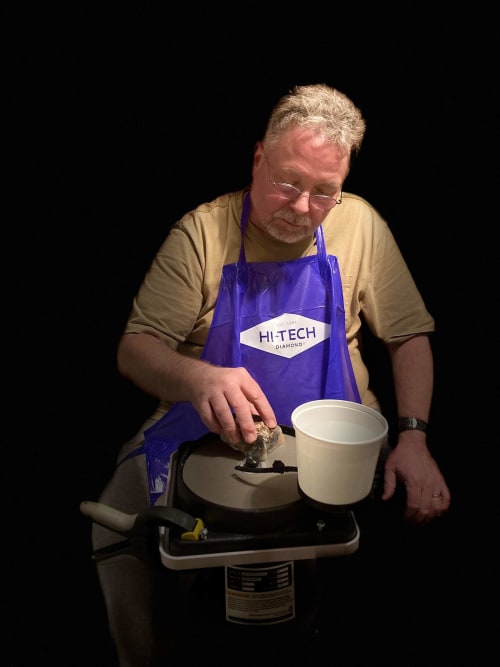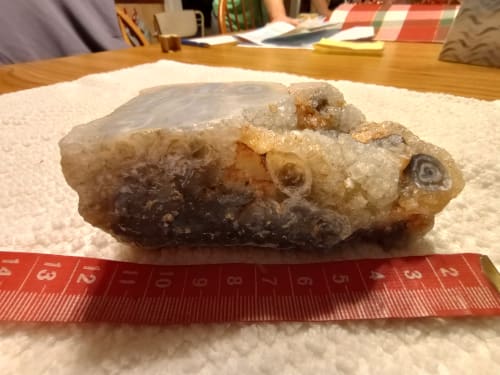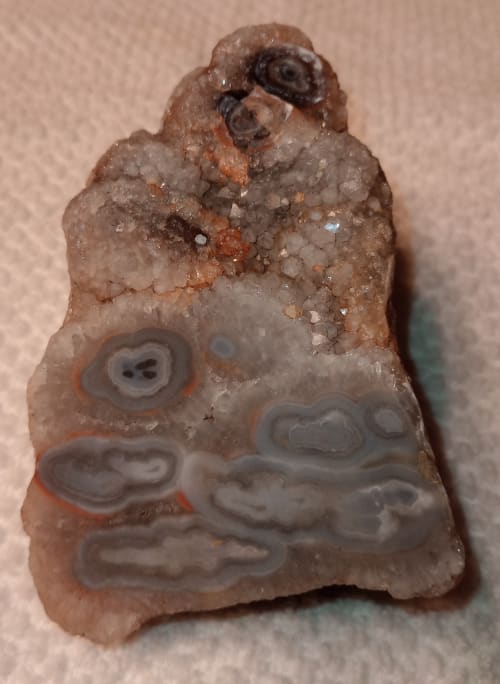dirtsifter
Cave Dweller  Co to za kamyczek?
Co to za kamyczek?
Member since September 2022
Posts: 402 
|
Post by dirtsifter on Jan 7, 2023 1:29:24 GMT -5
 So my wife took a fancy picture of me sitting down the first time using a Hi Tech flat lap. Came with a protective apron so...well there it is. A couple of pics of the stone I'm working on. Neither my wife nor I can remember when we picked up this little beauty but I guess 40 + years of finding neat rocks will do that to ya. I had an interesting read through some old posts here on the forum about flat laps. hummingbirdstones had a lot of good information. I have so much to learn. See my post on the Lessons learned from my first QT12 run. And this......so humbling. I have a question from those who flat lap. As one can see in the photo of the stone, it has already been cut..came that way. I attempted to, with the 180 diamond lap, remove the saw marks which really were few, then move on to the 1st smoothing disk. Frustrated at the results because I thought the surface was dead flat. In a corner of the stone, it was duller and showed some very fine scratches that don't show up in the rest of the surface. I worked on the #325 smoothing disk for 40 minutes but the problem seemed to worsen. I stepped back to the 180 and ground away. This did not improve the situation so I stopped. It was late in the night. Hummph. So here I am. What is the correct pressure to hold the stone against the lap. Maybe I'm pushing to hard and causing a deflection in the acrylic plate? I did constantly move the stone but is difficult to rotate more than 90 degrees because of the shape. Speed? I used 3 on the selector to start. When I went back to the 180 disk, I started loosing some of the interesting patterns so I stopped for advice.   The pictures are before I started. Don't have any progress photos yet. Thanks for reading, |
|
|
|
Post by jasoninsd on Jan 7, 2023 4:59:53 GMT -5
First, please let your wife know she did a fantastic job on the picture! I really thought it was an advertisement due to the very professional photo!
Second, I've spent a long time working on a slant cabber (it's a flat lap), but the higher grit disks had a cushioned back. I learned pretty quickly those aren't that great for "flat lapping" specimens...they really are for cabbing.
In my opinion, the 180 is going to take a very long time...like REALLY long time to get the saw marks out. You'd be better off working it on a 60 or 80 grit disk to start. That'll work enough material off the surface to get the rest of the surface down below those saw marks. It's a flat lap...so the entire surface area you're lapping has to be removed in order to get those saw marks out.
|
|
dirtsifter
Cave Dweller  Co to za kamyczek?
Co to za kamyczek?
Member since September 2022
Posts: 402 
|
Post by dirtsifter on Jan 7, 2023 5:22:55 GMT -5
First, please let your wife know she did a fantastic job on the picture! I really thought it was an advertisement due to the very professional photo! Second, I've spent a long time working on a slant cabber (it's a flat lap), but the higher grit disks had a cushioned back. I learned pretty quickly those aren't that great for "flat lapping" specimens...they really are for cabbing. In my opinion, the 180 is going to take a very long time...like REALLY long time to get the saw marks out. You'd be better off working it on a 60 or 80 grit disk to start. That'll work enough material off the surface to get the rest of the surface down below those saw marks. It's a flat lap...so the entire surface area you're lapping has to be removed in order to get those saw marks out. I'll let her know! You wouldn't want to see the background LOL Well, I got the saw marks off. I used a sharpie (learned from another older post I should probably use pencil to prevent possible staining of the stone) twice and thought it was dead flat. One thing I've noticed from watching others is to use BOTH washers to secure the lap. I used only one-I don't know if that made a difference. To me the instructions were not that clear. The problem was one corner that got progressively worse as I went. I used as even of pressure on the stone as I could and used a higher water flow than suggested as recommended by another person. The 180 really did not take long to remove about 1mm of stone. I removed enough that I'm losing some of the interesting patterns. I'll try marking up the bottom again to ensure I have the surface dead flat. When I get home from work in a couple of days, I'll try to get a picture of the problem. So much to learn. Thank you for your input. |
|
dirtsifter
Cave Dweller  Co to za kamyczek?
Co to za kamyczek?
Member since September 2022
Posts: 402 
|
Post by dirtsifter on Jan 7, 2023 9:24:17 GMT -5
4 hours ago jasoninsd said: First, please let your wife know she did a fantastic job on the picture! I really thought it was an advertisement due to the very professional photo! I facetimed with her this morning and she smiled and blushed that beautiful way she does and said "thank you" |
|
|
|
Post by mohs on Jan 7, 2023 9:52:25 GMT -5
hi dirtsifter
The amount of pressure is hard question
My thought is more pressure is better
My reasoning on this -
there is undercutting
In rocks with different
mineral composition
Its been a long time now
That I have ground any flats
the joining flats for the hearts
were a very small surface area and
found more pressure was better
Not really sure tho - what the best approach really is…
Tanks for the like on the old post!
Best
Ed
|
|
|
|
Post by rockjunquie on Jan 7, 2023 11:28:25 GMT -5
I'm with Jason, that's a fabulous picture. I love the lighting. Tell your wife she has another fan. 
I can't help with your problem, sorry.
|
|
|
|
Post by hummingbirdstones on Jan 7, 2023 11:52:29 GMT -5
dirtsifter Grinding flats evenly on the flat lap takes some patience and also some technique. The technique part is the hard part because a lot of it involves muscle memory, especially when you're grinding a large area. A couple of things to keep in mind: The lower the grit, the more subsurface damage you will have to clean up with progressive grits. This is explained in this article by Steve Attaway: Fine Cabinet Makers Don't Use Chain Saws. This is an article related to faceting, but the same concept will apply to any type of stone cutting. The more force you use to grind a stone, the more subsurface damage you will have. I have learned (the hard way) to use just enough force to hold the stone against the lap and let the diamonds do the work. It will take some time. Grinding flats can be terribly tedious. It is important to make sure that you are holding the stone to the lap as level to the flat area as possible. Here's where the muscle memory stuff comes in. All you have to do is apply just a little more pressure on one edge or the other at some point to make the flat a little uneven. As you can imagine, the lower the grit, the faster that will happen. When I am grinding a back flat on a cab (I don't do specimens) I will stand up to do it so i can hold my dop stick from directly above and apply pressure to the center of the stone to avoid leaning more to one side or another. It takes a while to for the muscle memory to build to the point where you don't have to think much about it. Also, applying a lot of downward force on your stone is going to tire you're arm out real quick! Use enough water to flush the swarf from the lap to keep the diamonds clear and cutting. Too much water will cause hydroplaning of the stone on the lap with no cutting happening. You will need to probably have a faster drip going on your lap for that size stone to keep the lap clean, but adjust it as you need to to get good results. On the 180 you will need more water than you will on the resin discs because you're not creating as much swarf. Hope that helps some. I think your wife did a great job on the photo, too!
|
|
dirtsifter
Cave Dweller  Co to za kamyczek?
Co to za kamyczek?
Member since September 2022
Posts: 402 
|
Post by dirtsifter on Jan 8, 2023 1:38:09 GMT -5
Thank you all for taking the time to give input to this thread! I appreciate it very much.
|
|
dirtsifter
Cave Dweller  Co to za kamyczek?
Co to za kamyczek?
Member since September 2022
Posts: 402 
|
Post by dirtsifter on Jan 8, 2023 1:41:10 GMT -5
dirtsifter Grinding flats evenly on the flat lap takes some patience and also some technique. The technique part is the hard part because a lot of it involves muscle memory, especially when you're grinding a large area. A couple of things to keep in mind: The lower the grit, the more subsurface damage you will have to clean up with progressive grits. This is explained in this article by Steve Attaway: Fine Cabinet Makers Don't Use Chain Saws. This is an article related to faceting, but the same concept will apply to any type of stone cutting. The more force you use to grind a stone, the more subsurface damage you will have. I have learned (the hard way) to use just enough force to hold the stone against the lap and let the diamonds do the work. It will take some time. Grinding flats can be terribly tedious. It is important to make sure that you are holding the stone to the lap as level to the flat area as possible. Here's where the muscle memory stuff comes in. All you have to do is apply just a little more pressure on one edge or the other at some point to make the flat a little uneven. As you can imagine, the lower the grit, the faster that will happen. When I am grinding a back flat on a cab (I don't do specimens) I will stand up to do it so i can hold my dop stick from directly above and apply pressure to the center of the stone to avoid leaning more to one side or another. It takes a while to for the muscle memory to build to the point where you don't have to think much about it. Also, applying a lot of downward force on your stone is going to tire you're arm out real quick! Use enough water to flush the swarf from the lap to keep the diamonds clear and cutting. Too much water will cause hydroplaning of the stone on the lap with no cutting happening. You will need to probably have a faster drip going on your lap for that size stone to keep the lap clean, but adjust it as you need to to get good results. On the 180 you will need more water than you will on the resin discs because you're not creating as much swarf. Hope that helps some. I think your wife did a great job on the photo, too! I did feel the hydroplaning with the #325 smoothing pad and slowed the water down. I've had some experience with that but I got some new tires...  |
|
dshanpnw
freely admits to licking rocks
  
Member since December 2020
Posts: 892
|
Post by dshanpnw on Jan 8, 2023 7:46:14 GMT -5
The photo of you is awesome. I thought it was advertisement also. I don't have a flat lap, but I use discs for sanding my flats, and I have similar problems when trying to get a completely flat surface. Sometimes nothing works and I blame that on the discs more than the rock. I'm thinking a steel 80 grit disc would do the trick instead of a softer backed one. I share your frustrations.
|
|
|
|
Post by hummingbirdstones on Jan 8, 2023 11:11:39 GMT -5
Master laps with diamond lap toppers would be the best to use for flats. We have a steel master lap with an array of diamond toppers that I use for doing cab backs. Acrylic laps, even with no cushion backing, still have a little "give" to them. Kingsley North has an aluminum backing plate that is less expensive than the steel ones and it would do the job.
|
|
geoff59
spending too much on rocks
 
Member since October 2022
Posts: 278
|
Post by geoff59 on Jan 14, 2023 7:18:03 GMT -5
I’m a relative newbie with a flat-lap as well, have one here, haven’t done a whole lot with it yet. So threads like this are interesting. I’ve run in to some of the same issues/questions as you have. I went ahead and purchased from HiTech, #80, and #360 Diamond discs to go with the #180 they include with the machine. Eventually I will end up with the whole series of them, just not yet. I can tell you that the #80 disc is worth buying and makes grinding go faster. I run a pretty good rate of drip, and subscribe to the comment about letting the diamonds do the work. I don’t put a lot of pressure on the rock, I think I tend to lose the control of the grind that way.
oh and, as a photographer of sorts, yeah that photo more or less just jumps out at you as you see it, it is a great image of you!
|
|